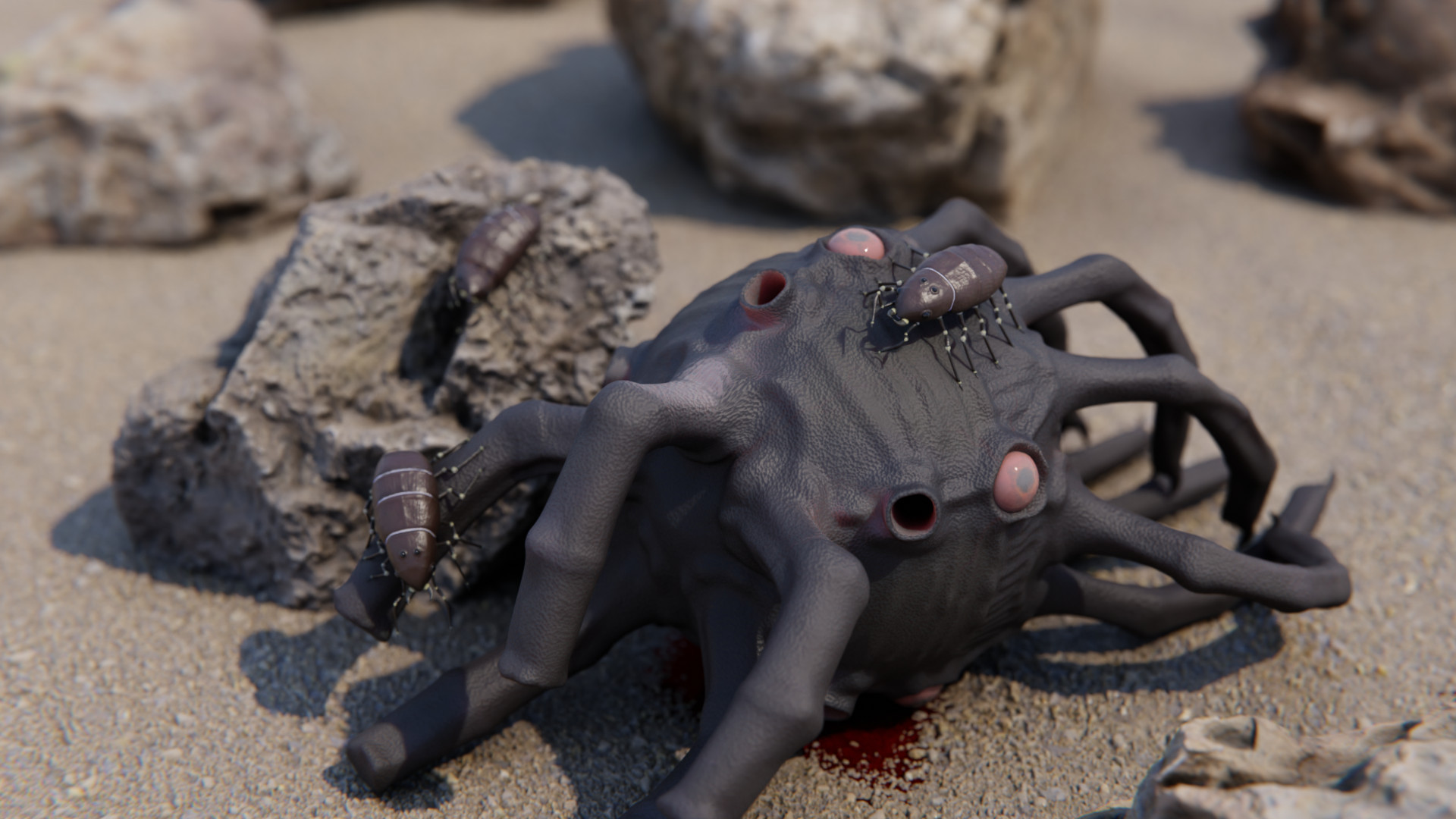Romulopede
On a sunny day along the estuary riverbanks of western Kub Shay, there laid the limp body of a deceased barreldactyl. One of the first visitors to the carcass is a small cockroach-like creature, emerging from the crevices of a nearby boulder as it is enticed by the smell of carrion. It darts erratically towards the source of the rotten stench, before clambering on top of the carcass and beginning feeding. Soon others converge to feast, as this is too much for only one animal to feed on, as pictured here.
Romulopedes are small terrestrial generalists that are found ubiquitously around sources of brackish to fresh water. Their long legs and flat body gives them the mobility and nimbleness to evade predators and hide among narrow spaces. Romulopedes belong to a group of moulting xenosegmatans known as the ecdysopods, which also includes the sister-group remapedes. [Creature design by Squiddum]
Basic Information
Anatomy
The ancestors of romulopedes experienced duplicate segmentation of the last segment, adding an additional three segments at the posterior end. Tagmosis merged the anterior two segments into the head, while the remaining four segments were grouped together into the abdomen. This has thus formed the basic body plan of the romulopede.
The overall body of a romulopede is flat, with an exoskeleton of keratin that covers the entire body. The limbs are jointed and very long in comparison with the rest of the body, being positioned laterally and ending in a single tiny claw. The head contains 2 pairs of compound eyes, with the anterior pair being the largest and oriented laterally. The posterior pair is slightly smaller and is oriented dorsally. The mandibles are pointed with slight serrations, and flanking the mandibles are a pair of pedipalps lined with sensory setae.
In place of the gill fronds, a tracheal system has developed to facilitate respiration, with the spiracles situated laterally on the ventral side of the abdomen. A stomach cavity is situated within the head, while the intestines extend down the abdomen. romulopedes possess an open circulatory system with a tubular heart along the dorsal side of the thorax, as well as a simple nervous system composed of a rudimentary brain at the head and two ganglia trailing down the abdomen.
Genetics and Reproduction
Romulopedes are sequential hermaphrodites and are all born as females. At around 1.5 local years of age, Romulopedes will undergo a final moult in a female-to-male transition, making them males for the rest of their lives. Romulopedes mate by orienting themselves opposite to each other, such that their cloacae touch together to facilitate sperm transfer. Females then lay eggs within a shallow body of water, usually around crevices of a rock or retinalphyte stems. Females are also able to lay parthenogenetic eggs if no males are present within the vicinity.
Growth Rate & Stages
Romulopedes begin life in their aquatic larval form during the first part of their life cycle. Larvae hatch at 0.5cm in length and are anatomically similar to the adults, except for the presence of gill fronds on the abdomen of the larva. The larva’s exoskeleton is a flexible cuticle that is much softer than the exoskeleton of its later instars.
At 30 local days of age and reaching 2.5cm in length, the Romulopede larvae emerge onto land and molt for the first time, serving as the transition to their fully-terrestrial adult form. After the first molt, a tracheal system would have developed in place of the now vestigial gill fronds. The appendages continue to shrink in size every moult, until they disappear completely by the third moult.
From this point on, the romulopede needs to continue molting in order to grow larger, at least until their final molt. This is initiated by a slit forming laterally on the dorsal portion of the old exoskeleton, through which the newly molted romulopede crawls out of. Romulopedes have the ability to regenerate wounds and regrow lost limbs through molting, but after each molt the new exoskeleton needs some time before becoming fully hardened. Molting of the terrestrial instars occurs roughly every 7 local days. By the 3rd molt, the romulopede enters sexual maturity and is a fertile female. At the 7th molt, the romulopede enters an infertile intersex stage as its internal anatomy begins sexual transition. By the 8th and final moult, the romulopede emerges as a fertile adult.
Ecology and Habitats
Romulopedes inhabit the western side of Kub Shay, never found far from sources of freshwater. While the adults are able to survive on land, their larval form is aquatic and therefore they must return to water to ovulate. As omnivorous opportunists, romulopedes will eat any retinalphytes and carrion they can reach and consume. If sufficiently starved, one may attempt to prey on smaller organisms, even resorting to cannibalism of smaller romulopedes. Though they possess a light exoskeleton and high agility, they are regularly preyed upon by many terrestrial predators.
Additional Information
Perception and Sensory Capabilities
The compound eyes on the romulopede’s head provide decent vision capabilities along with a wide field of view, enabling the romulopede to react quickly to approaching predators. The setae on the pedipalps are capable of picking up olfactory queues by taste and smell. Smaller, invisible setae lining the whole body can also sense disturbances in air currents, potentially caused by movement of larger creatures.
EXTINCT
Genetic Ancestor(s)
Scientific Name
Platygaster herri
Origin/Ancestry
Xenosegmenta
Lifespan
2 local years
Average Height
3 cm
Average Length
7 cm
Remove these ads. Join the Worldbuilders Guild











Comments